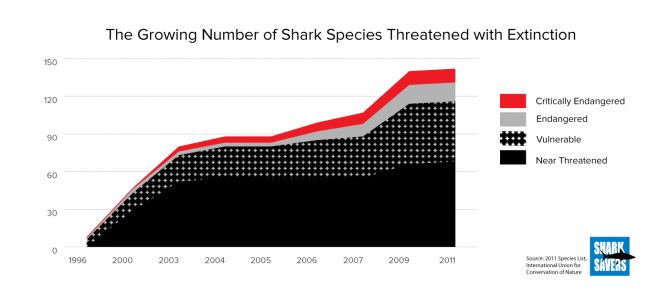Demand for shark fin soup is so great that within a few short decades sharks have been dangerously overfished. Each year, tens of millions of sharks are killed with their fins destined for the shark fin trade1. It is the demand for fins—much more than the meat—that is driving this unsustainable depletion of sharks. The value of fins is as much as 20 to 250 times that of the meat2.
Based on reports of the highly respected International Union for Conservation of Nature (IUCN), the only international scientific body that assesses extinction risk for plant and animal species:
1/3 of all shark species are threatened with extinction.3
80% of open ocean shark species frequently targeted in high seas fisheries are threatened or near threatened with extinction.4
All 14 species of shark most prevalent in the shark fin trade are Threatened or Near Threatened with extinction.5

Hammerhead, Silky, Oceanic, Sandbar, Shortfin Mako, Bull and Tiger sharks, all predominant in the shark fin trade, have experienced population declines of 90-99% in several areas where they were naturally plentiful.6
Most of the shark species that are regularly targeted for their fins are slow to mature, reproduce infrequently and only have a few pups at a time7. This makes it very difficult for sharks to recover from relentless overfishing.
The low reproductive ability of sharks is in stark contrast to most other fish that have evolved with higher reproductive abilities in order for their populations to survive predators. Sharks, on the other hand, had few predators for hundreds of millions of years until humans began to aggressively target them about 30 years ago.
1 - Clarke S.C., Magnussen, J.E., Abercrombie, D.L., McAllister, M.K., Shivji, M.S. 2006. Identification of shark species composition and proportion in the Hong Kong shark fin market based on molecular genetics and trade records. Conservation Biology, 20(1): 201-211
2 - Vannuccini, S. 1999. Shark Utilization, Marketing and Trade. FAO Fisheries Technical Paper 389, Rome, 470 pp.
3 - Hoffmann, M., C. Hilton-Taylor, et al. 2010. The impact of conservation of the status of the world's vertebrates. Science, 330: 1503-1509.
4 - Dulvy, N.K., Baum, J.K., Clarke, S., Compagno, L.J.V., Cortes, E., Domingo, A., Fordham, S., Fowler, S., Francis, M.P., Gibson, C., Martinez, J., Musick, J.A., Soldo, A., Stevens, J.D., and Valenti, S. 2008. You can swim but you can’t hide: the global status and conservation of oceanic pelagic sharks and rays. Aquatic Conservation Marine and Freshwater Ecosystems, 18: 459-482
5 - Clarke S.C., Magnussen, J.E., Abercrombie, D.L., McAllister, M.K., Shivji, M.S. 2006. Identification of shark species composition and proportion in the Hong Kong shark fin market based on molecular genetics and trade records. Conservation Biology, 20(1): 201-211; IUCN 2011. IUCN Red List of Threatened Species. Version 2011.2. <www.iucnredlist.org>. Downloaded on 05 June 2012.
6 - *Refer to Shark Savers download “Shark Declines – SFT Species”, Ferretti et al. 2008; Myers et al. 2007; Baum and Myers 2004; Bonfil et al. 2009; U.S. Pelagic Longline logbook data; Musick et al. 2009; Boero and Carli 1979; Baum et al. 2003; NMFS Stock Assessment
7 - Frisk, M.G., Miller, T.J., and Dulvy, N.K. 2005. Life histories and vulnerability to exploitation of elasmobranchs: inferences from elasticity, perturbation and phylogenetic analyses. Journal of Northwest Atlantic Fisheries Science, 35: 27-45.